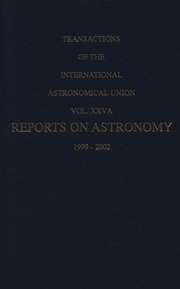No CrossRef data available.
Article contents
34. Interstellar Matter and Planetary Nebulae (Matiére InterstellAire et Nébuleuses Planétaires)
Published online by Cambridge University Press: 25 April 2016
Extract
It is now recognized that diffuse matter in space plays a decisive role in the evolution of our Galaxy and of similar galaxies. Primordial gas—together with gas ejected in planetary nebulae, stellar winds, novae, supernovae, and other types of stars—has accumulated to form a complex medium containing regions with densities ranging from 10–3 to 106 particles cm-3 and with temperatures ranging from 10 K to 106 K. From time to time, part of the interstellar medium collapses to form stars. In order to understand the evolution of the Galaxy, it is essential to understand how energy, mass, trace elements, and dust grains are deposited into the interstellar medium by stars. It is also essential to understand the mechanisms that initiate star formation in certain regions, and how the ensuing collapse develops in space and time.
- Type
- Research Article
- Information
- Copyright
- Copyright © Reidel 1979


